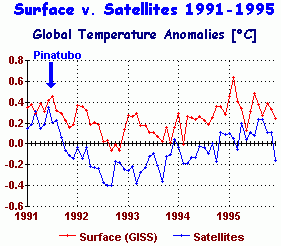Posted by bobbapink on Jun 25, 2002 at 08:58
(208.58.228.234)
A recent paper in Science titled "Global Cooling After the Eruption of Mount Pinatubo: A Test of Climate Feedback by Water Vapor" (Soden et al. v.296, p.727, 26 Apr 02) set out to prove the `mountain out of a molehill' approach to global warming adopted by the IPCC (where an initial CO2 warming of less than 1°C blows out to nearly 6°C when `feedbacks' are applied, especially feedbacks from water vapour, a greenhouse gas).
The reasoning was that since the Pinatubo eruption of June 1991 caused reduced energy to the lower atmosphere, thus cooling it, then the magnitude of that cooling could be used to test the degree to which water vapour magnified that cooling. If it did, then we could also expect it to magnify warming from CO2 over and above the basic ~1°C warming from CO2 doubling.
We already know what the reduction in received energy was after the Pinatubo eruption - 2.7 watts per sq. mtr. (wm-2) (Minnis et al. Science v.259, p.14, 5 March 1993). Using the Stefan-Boltzmann equation, that translates to a temperature reduction of -0.5°C without feedbacks. In other words, if water vapour was to have the feedback effect claimed for it by the models, the peak Pinatubo cooling would have to exceed -0.5°C.
The world did cool, briefly, by -0.7°C., according to the satellite record, seemingly supporting the `water vapour did it' hypothesis promoted by Soden et al.
But there was just one little catch - the surface record, favoured by the IPCC, showed a cooling slightly less than the required 0.5°C not more. In other words, if the surface record were to be believed, water vapour feedback had absolutely no effect at all. In that situation, the models really were making a mountain out of a molehill with no physical evidence to support their alarmist global warming claims.
So the authors resorted to using the satellite record instead of the surface record. It showed a larger cooling of 0.7°C, the additional increment of 0.2°C being promptly blamed on water vapour feedback, thus barely supporting their water vapour feedback hypothesis.

Even using the satellites, the water vapour feedback only added an extra 40% to the cooling, not the 500% which the IPCC says might happen with a basic CO2 warming of around 1°C. But the use of the satellites in this way opens a new can of worms.
If the surface record shows no evidence of feedback and resort to the satellites is made to demonstrate even a small feedback, then how does the IPCC explain the overall 23-year satellite record, which suggests an eventual warming of only a few tenths of a degree?